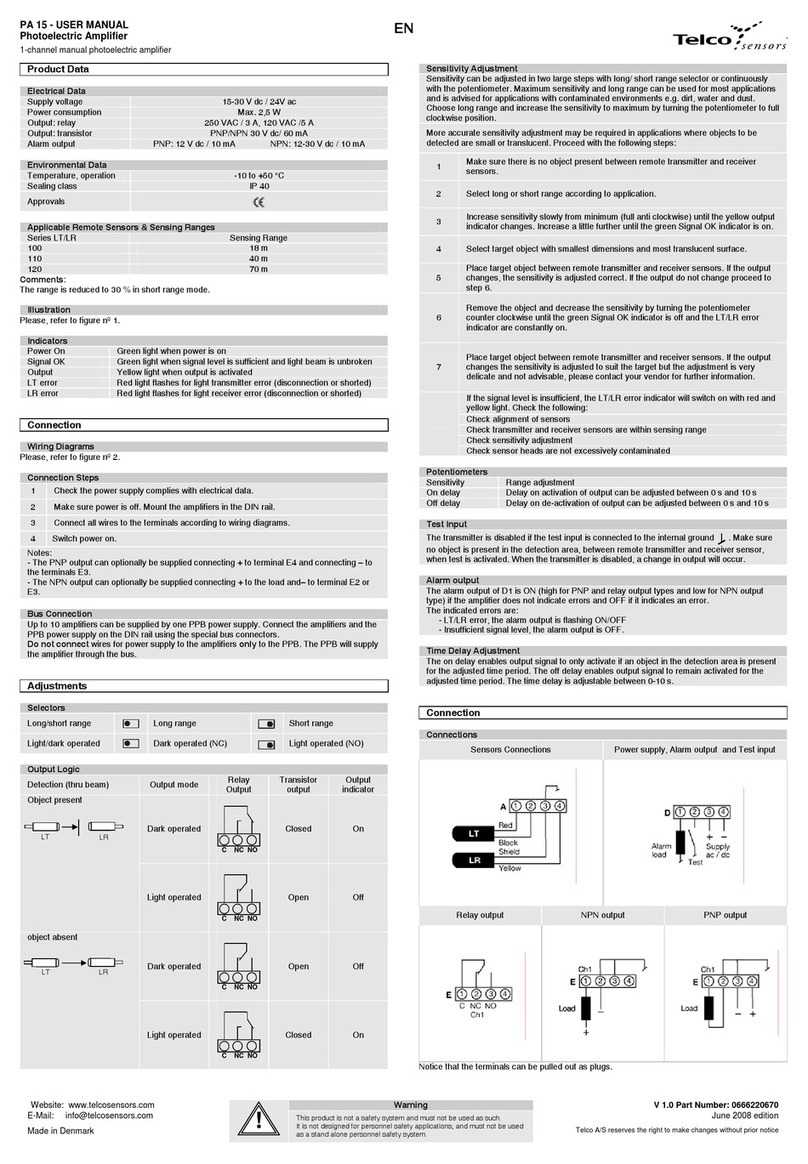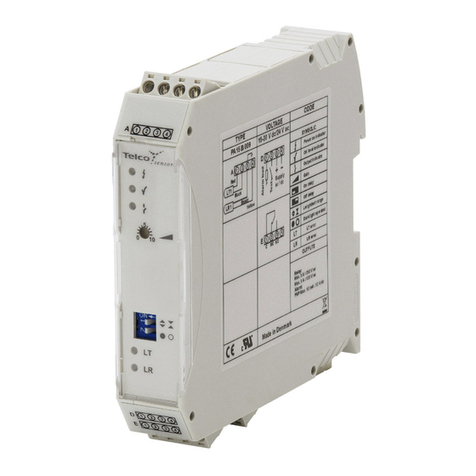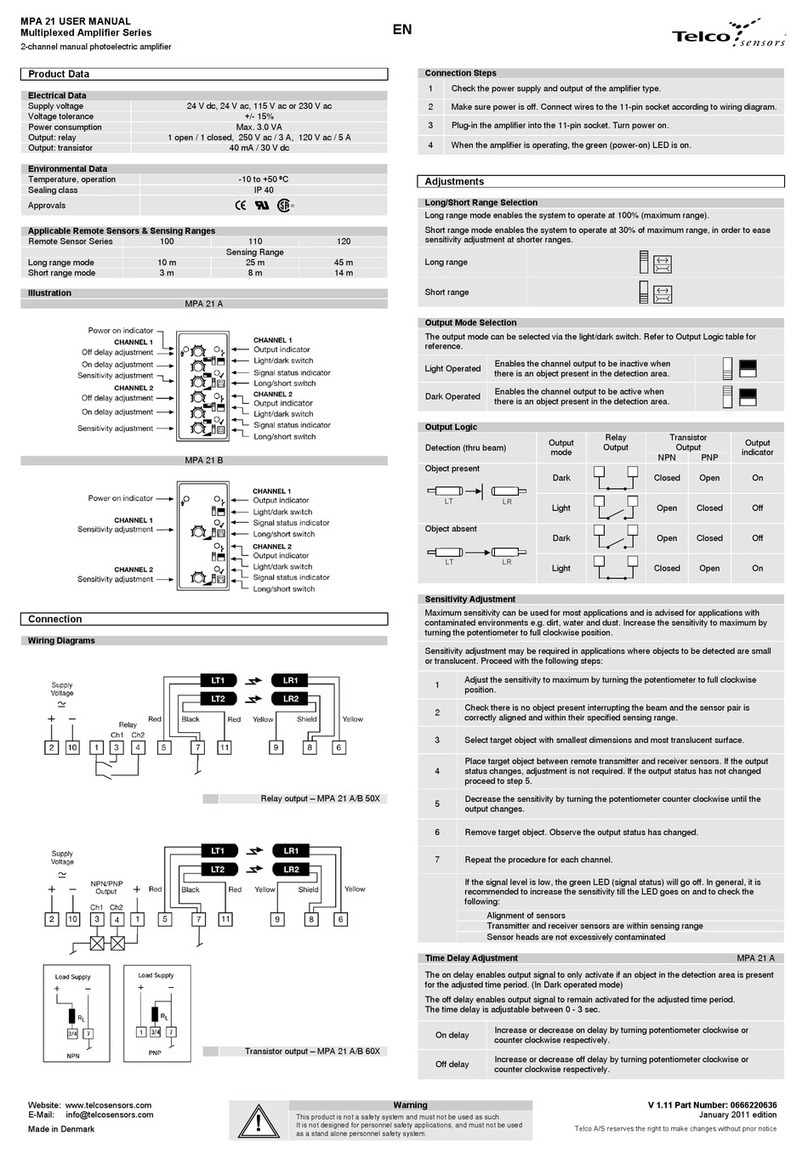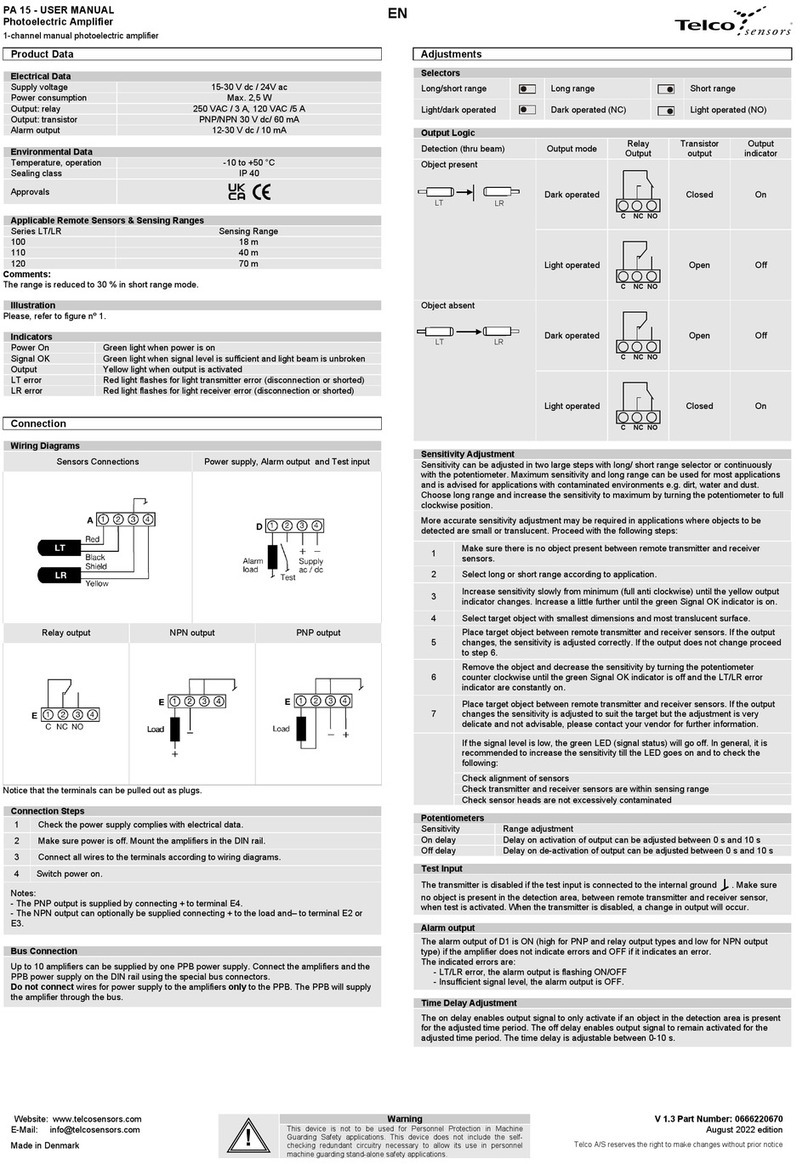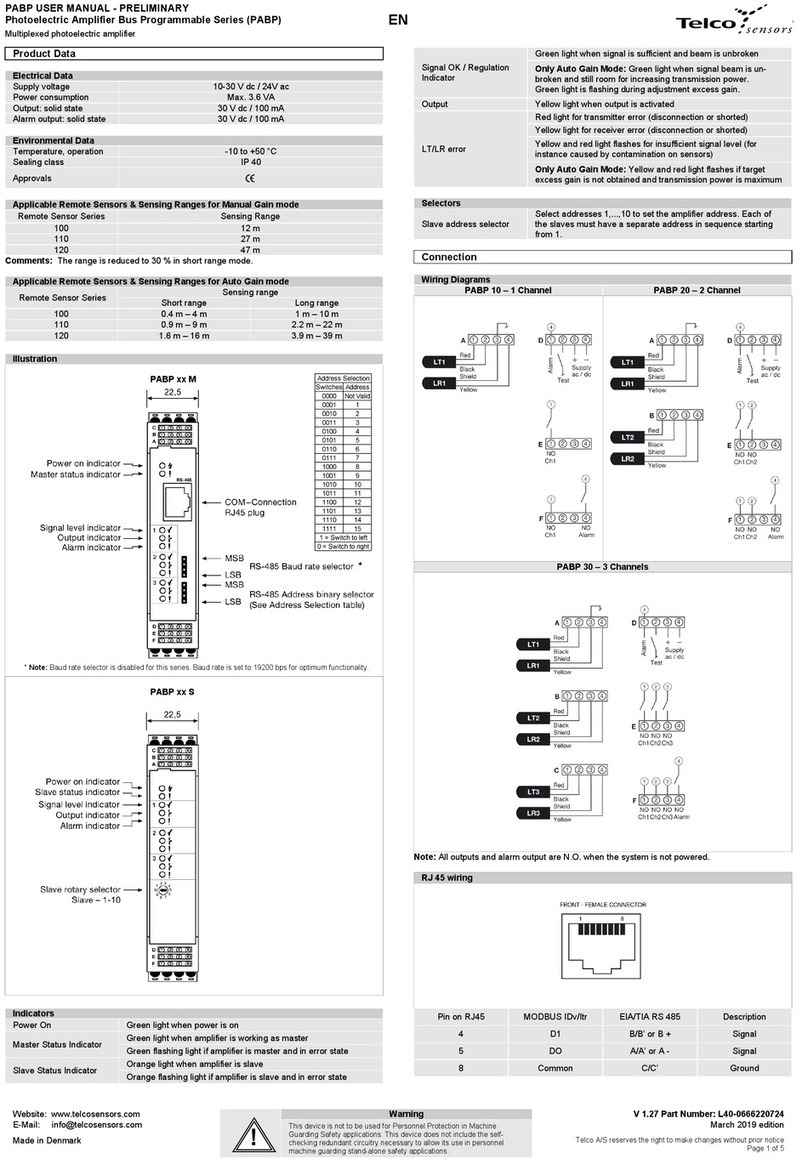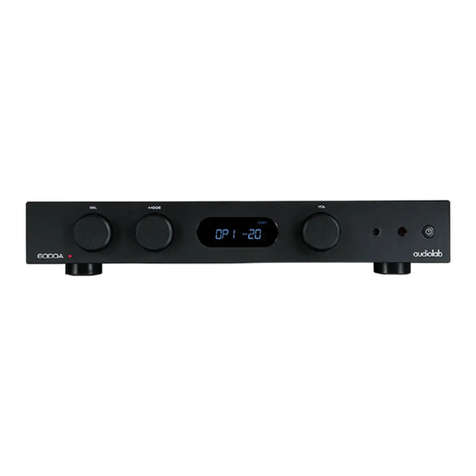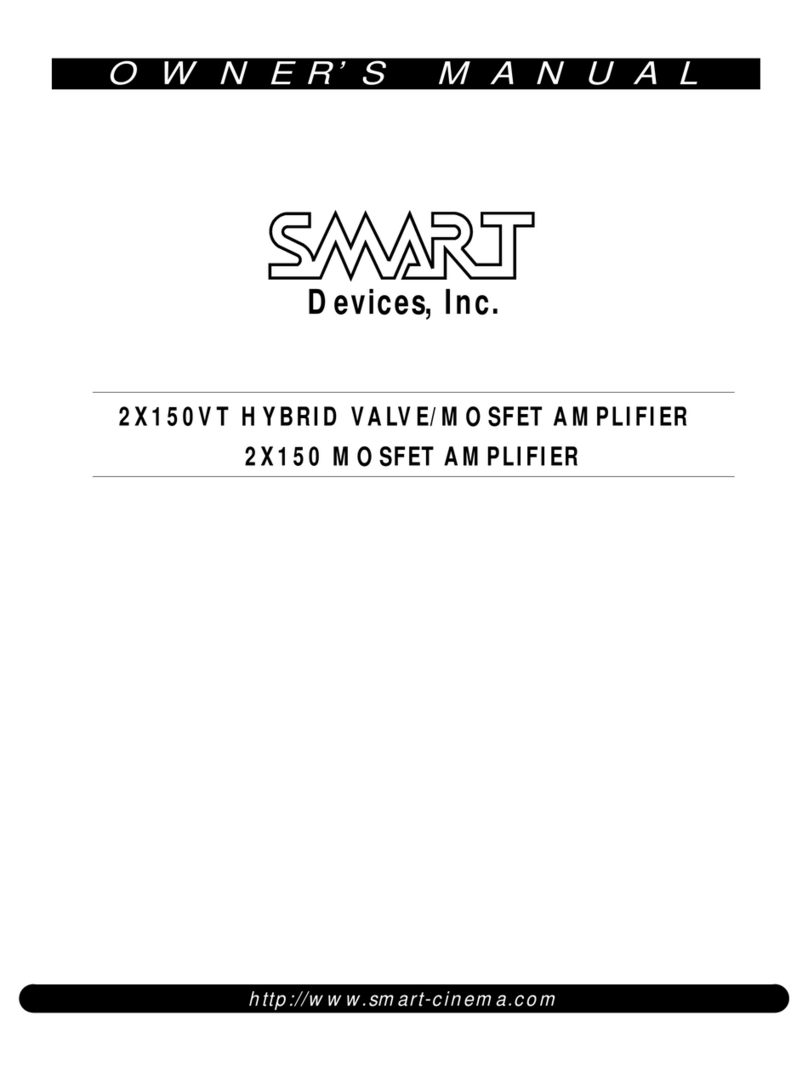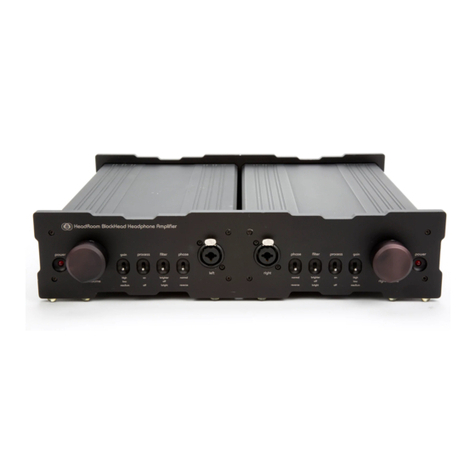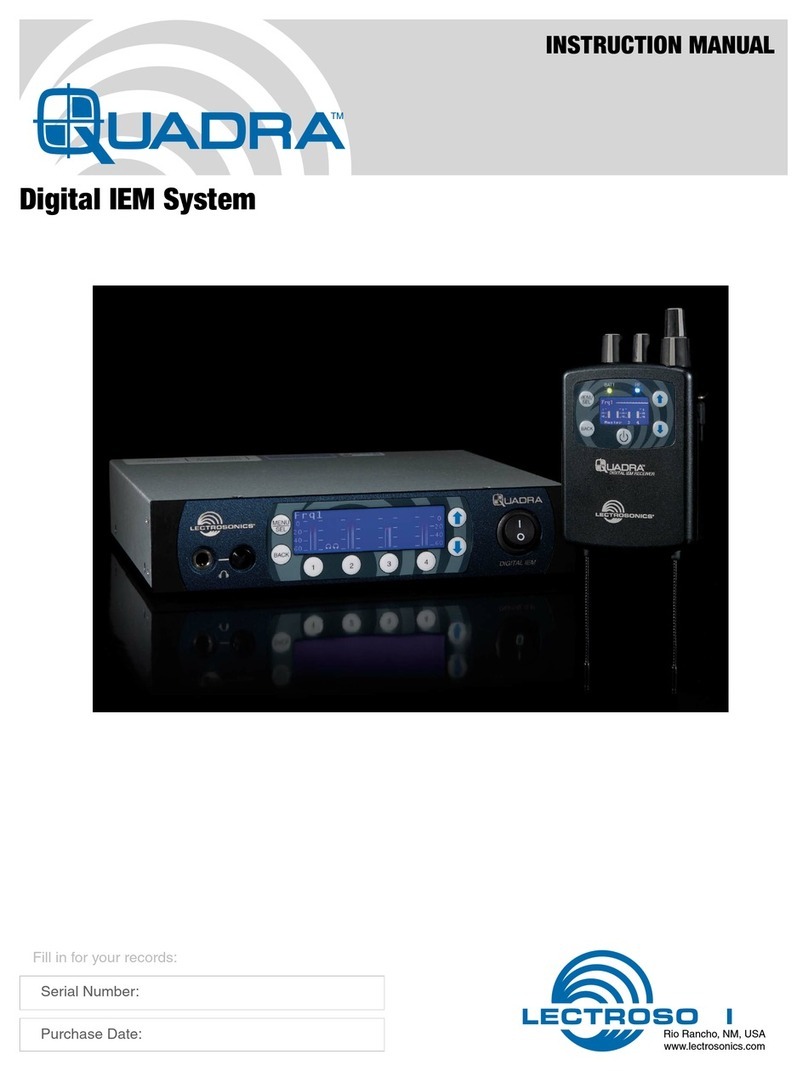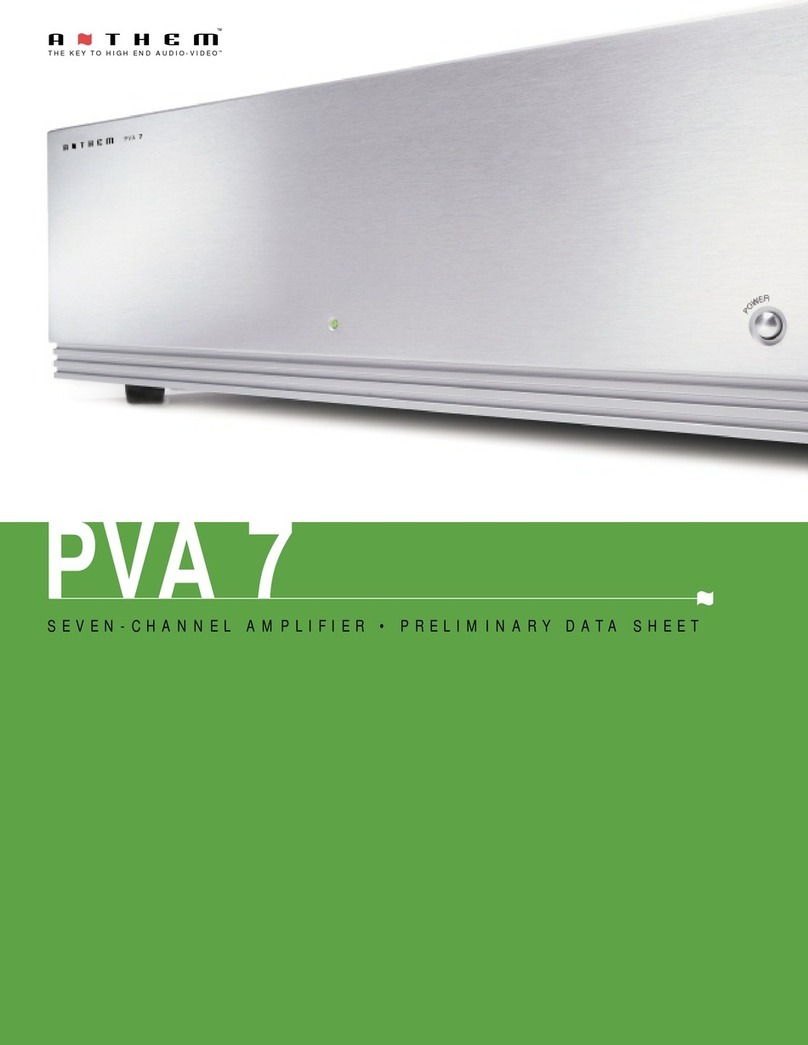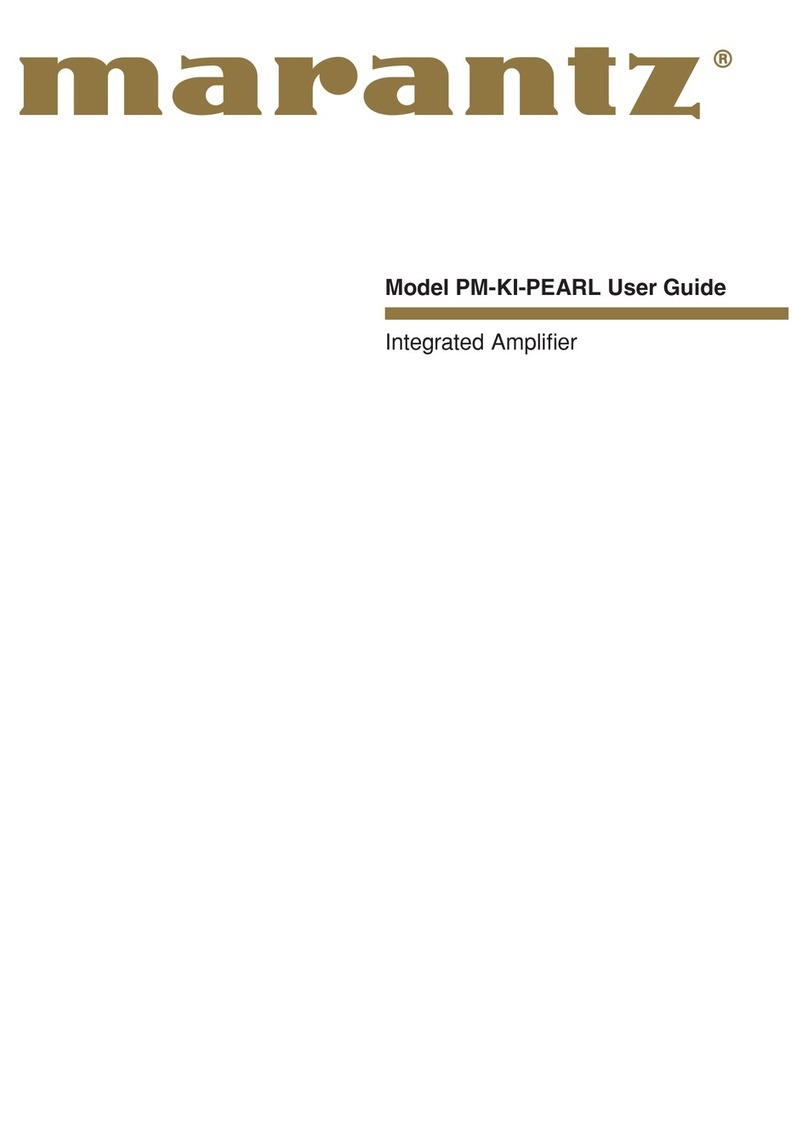Telco Sensors PAB S Series User manual

PAB USER MANUAL
Photoelectric Amplifier Bus Single Series (PAB xx S)
Multiplexed photoelectric amplifier
Website: www.telcosensors.com
Warning
V 1.2 Part Number: 0666220646
E-Mail: info@telcosensors.com
This device is not to be used for Personnel Protection in Machine
Guarding Safety applications. This device does not include the self-
checking redundant circuitry necessary to allow its use in personnel
machine guarding stand-alone safety applications.
February 2020 edition
Made in Denmark
Telco A/S reserves the right to make changes without prior notice
tel
EN
Product Data
Electrical Data
Supply voltage
10-30 V dc / 24V ac or 90-240 V ac
Power consumption
Max. 3.6 VA
Output: relay
250 VAC / 3 A, 120 VAC /5 A
Output: transistor
PNP/NPN 30 V dc/ 100 mA
Alarm output
PNP/NPN 30 V dc/ 100 mA
Environmental Data
Temperature, operation
-10 to +50 °C
Sealing class
IP 40
Approvals
Applicable Remote Sensors & Sensing Ranges
Remote Sensor Series
Sensing Range
PAB 20 & PAB 30
(2 and 3 channels multiplexed)
PAB 10
(1 channel)
100
12 m
18 m
110
27 m
40 m
120
47 m
70 m
Comments:
The range is reduced to 30 % in short range mode.
Illustration
Please, refer to figure nº 1.
Indicators
Power On
Green light when power is on
Signal OK
Green light when signal is sufficient and beam is unbroken
Output
Yellow light when output is activated
LT/LR error
Red light for light transmitter error (disconnection or shorted)
Yellow light for light receiver error (disconnection or shorted)
Yellow and red light flashes for insufficient signal level (for
instance caused by contamination on sensors)
Connection
Wiring Diagrams
Please, refer to figure nº2.
Connection Steps
1 Check the power supply complies with electrical data.
2
Make sure power is off. The amplifiers can be powered using the terminal D3 and D4 or
through the bus connector, for instance, using a PPB power supply or from another
amplifier with the terminals D 3 and D 4 already connected (powered).
3
Mount the amplifiers in the DIN rail. And connect all wires to the terminals according to
wiring diagrams.
4 Select the mode of operation. Switch power on.
Notes:
- The PNP output can optionally be supplied connecting + to terminal E4 and connecting – to
the terminals E3 on PAB 10 and F4 on PAB 20 and PAB 30.
- The amplifiers model X08 (ac version) cannot power other units through the bus.
Adjustments
Selectors
Short / Long range
Short range
Long range
Light / Dark operated
Light operated
Dark operated
Common / Individual
(Only in PAB 20 & PAB 30)
Common output
Individual outputs
Output Logic
Detection (thru beam) Output mode
Relay
Output
Transistor
Output
Output
indicator
Object present
Dark operated
Closed On
Light operated
CNC NO
Open Off
Object absent
Dark operated
CNC NO
Open Off
Light operated
CNC NO
Closed On
Sensitivity Adjustment
The sensitivity can be adjusted in two large steps with long/ short range selector or
continuously with the potentiometer. Maximum sensitivity and long range can be used for most
applications and is advised for applications with contaminated environments e.g. dirt, water
and dust.
Chose long range and increase the sensitivity to maximum by turning the potentiometer to full
clockwise position.
More accurate sensitivity adjustment may be required in applications where objects to be
detected are small or translucent. Proceed with the following steps:
1 Make sure there is no object present between remote transmitter and receiver
sensors.
2
Select long or short range according to application.
3 Increase sensitivity slowly from minimum (full anti clockwise) until the yellow output
indicator changes. Increase a little further until the green Signal OK indicator is on.
4
Select target object with smallest dimensions and most translucent surface.
5
Place target object between remote transmitter and receiver sensors. If the output
changes, the sensitivity is adjusted correct. If the output do not change proceed to
step 6.
6
Remove the object and decrease the sensitivity by turning the potentiometer
counter clockwise until the green Signal OK indicator is off and the LT/LR error
indicator flashes simultaneously with red and yellow light
7
Place target object between remote transmitter and receiver sensors. If the output
changes the sensitivity is adjusted to suit the target but the adjustment is very
delicate and not advisable, please contact your vendor for further information.
If the signal level is low, the LT/LR error indicator flashes simultaneously with red
and yellow light. Check the following:
Alignment of sensors
Transmitter and receiver sensors are within sensing range
Sensor heads are not excessively contaminated
Available Models
Models
Output
Nº of channels
Common output
PAB 10 S
00x
Relay
1 N/A
10x
NPN
20x
PNP
PAB 20 S
00x
Relay
2 (Multiplexed) Yes
10x
NPN
20x
PNP
PAB 30 S
00x
Relay
3 (Multiplexed) Yes
10x
NPN
20x
PNP
Test Input
The transmitter is disabled if the test input is connected to the internal ground (A3). Make
sure no object is present in the detection area, between remote transmitter and receiver
sensor, when test is activated. When the transmitter is disabled, a change in output will occur.
Alarm output
The alarm output voltage of D1 is high if the amplifier does not indicate errors and low if it
indicates an error. The indicated errors are: LT/LR error and insufficient signal level. In the
case of insufficient signal level the alarm output is flashing.
Turning off a channel
On the PAB’s amplifiers is possible to turn off its channels. This is done by turning the
sensitivity potentiometer fully anti clock wise. The channel will then be completely ignored by
the PAB.
On the 2 and 3 channels model, if one channel (on PAB 20) or two channels (on PAB 30) are
turned off, the PAB will function as a 1 channel amplifier. Consequently the PAB will be non-
multiplexed and have sensing range accordingly.
Time Delay Adjustment
The on delay enables output signal to only activate if an object in the detection area is present
for the adjusted time period. The off delay enables output signal to remain activated for the
adjusted time period. The time delay is adjustable between 0-10 s.
LT
LR
LT
LR
CNC NO
!

PAB USER MANUAL
Photoelectric Amplifier Bus Single Series (PAB xx S)
Multiplexed photoelectric amplifier
Website: www.telcosensors.com
Warning
V 1.2 Part Number: 0666220646
E-Mail: info@telcosensors.com
This device is not to be used for Personnel Protection in Machine
Guarding Safety applications. This device does not include the self-
checking redundant circuitry necessary to allow its use in personnel
machine guarding stand-alone safety applications.
February 2020 edition
Made in Denmark
Telco A/S reserves the right to make changes without prior notice
tel
Ilustration Fig. 1
Abbildung Fig.1
Note: Drawing of PAB 30 S model.
ANM: Zeichnung PAB 30 S
Ilustration Fig.1 Ilustración Fig. 1
Note: PAB 30 S
Nota: Dibujo del modelo PAB 30 S.
!

PAB USER MANUAL
Photoelectric Amplifier Bus Single Series (PAB xx S)
Multiplexed photoelectric amplifier
Website: www.telcosensors.com
Warning
V 1.2 Part Number: 0666220646
E-Mail: info@telcosensors.com
This device is not to be used for Personnel Protection in Machine
Guarding Safety applications. This device does not include the self-
checking redundant circuitry necessary to allow its use in personnel
machine guarding stand-alone safety applications.
February 2020 edition
Made in Denmark
Telco A/S reserves the right to make changes without prior notice
tel
Connections Fig. 2
PAB 10
Sensors Connections
Relay output (PAB 10 S 00x)
NPN output (PAB 10 S 10x)
PNP output (PAB 10 S 20x)
PAB 20
Sensors
Relay output (PAB 20 S 00x)
NPN output (PAB 20 S 10x)
PNP output (PAB 20 S 20x)
PAB 30
Sensors
Relay output (PAB 30 S 00x)
NPN output (PAB 30 S 10x)
PNP output (PAB 30 S 20x)
!
This manual suits for next models
3
Other Telco Sensors Amplifier manuals
Popular Amplifier manuals by other brands

SMSL
SMSL SH-6 manual

Yamaha
Yamaha AS1000 - Amplifier owner's manual

Powerwave Technologies
Powerwave Technologies MCA9000-400 Series Service & installation manual
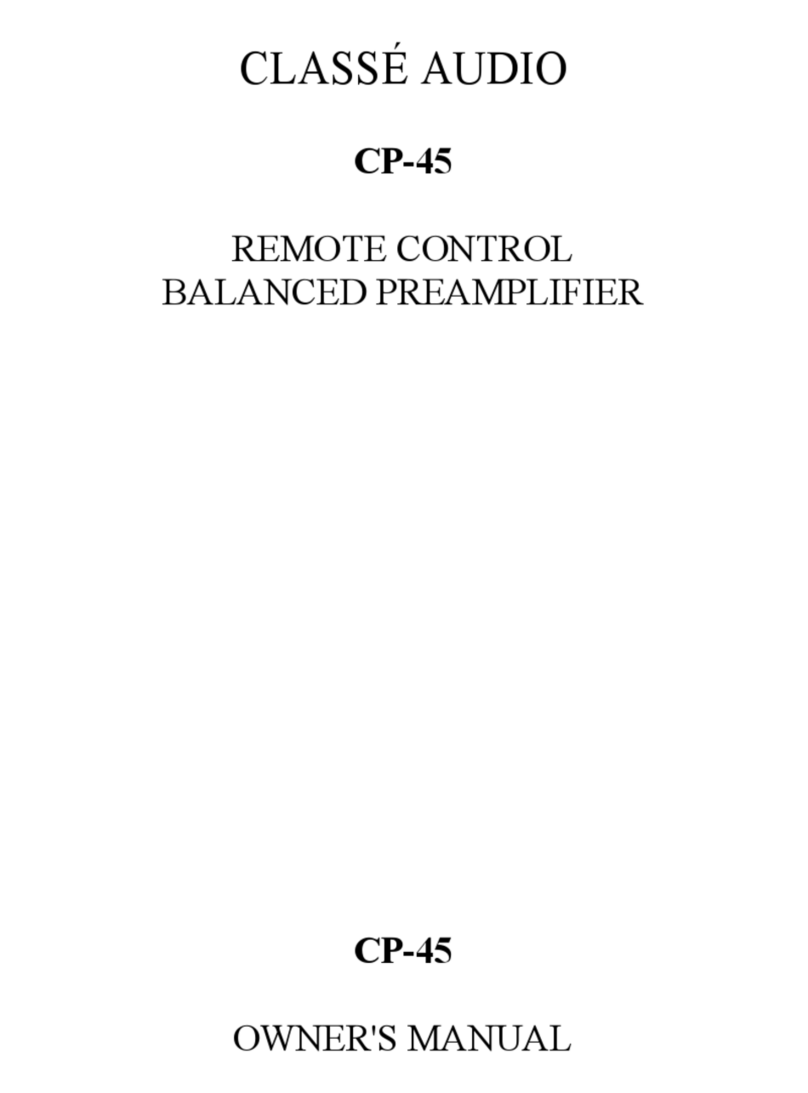
Classe Audio
Classe Audio CP-45 owner's manual
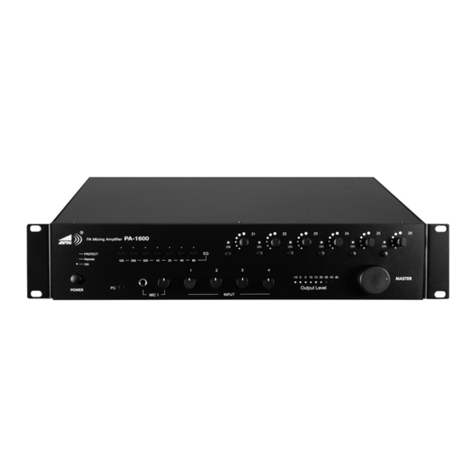
Audio-Visual Station
Audio-Visual Station PA-1600 operating instructions

AMAV
AMAV VGA 12 Installation and operation manual
